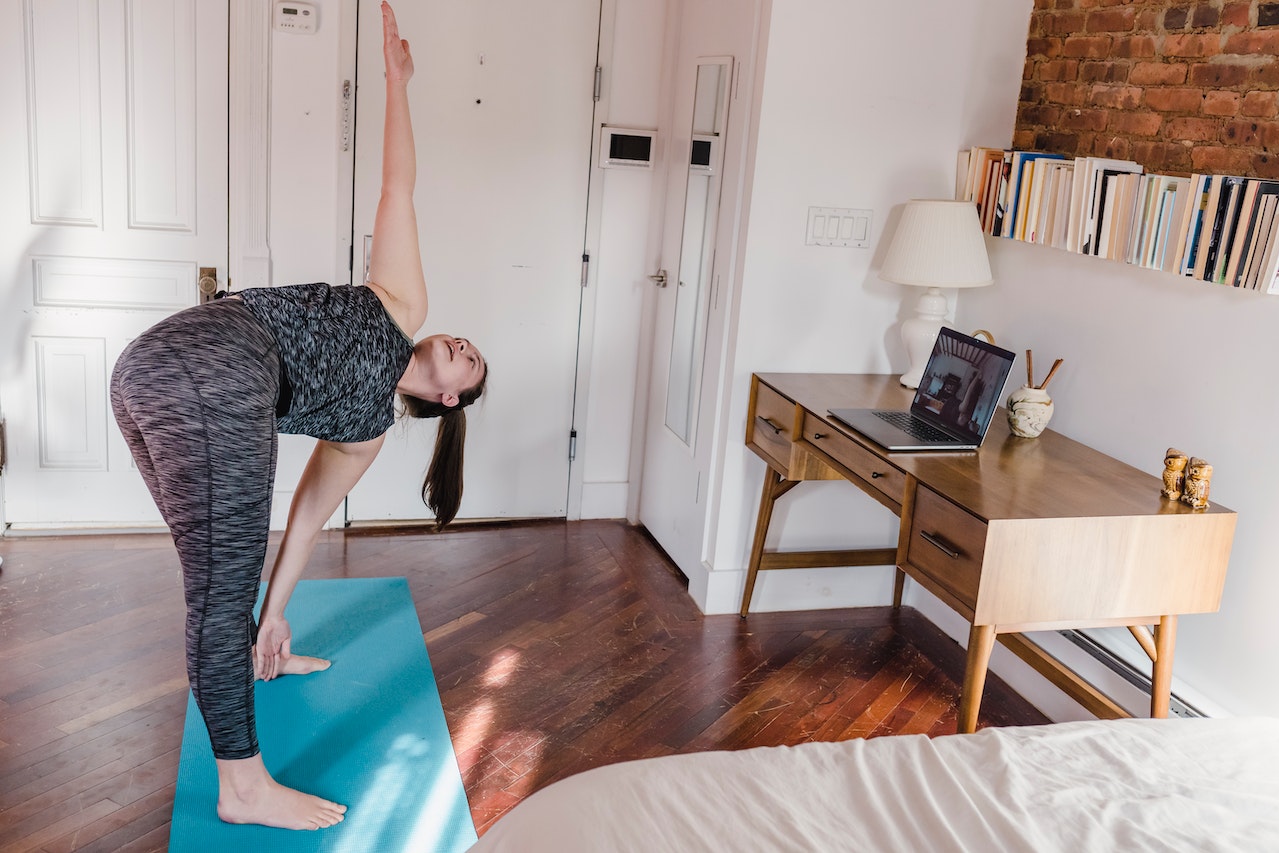why taking an online yoga teacher training?

Considering becoming a yoga instructor but have yet to find the time to enroll in a traditional classroom-based course? The next best option is to get qualified online.
Remote yoga teacher training courses allow you to start your new career from the convenience of your own home, delivered at your own pace. You’ll be gifted the skills, knowledge, and confidence to start the exciting and nourishing journey of becoming a yoga instructor.
Yoga cultivates “a beginner’s mind,” a mindset of humility and presence as you learn something new – and that, of course, applies to starting online yoga teacher training.
Embarking on this journey may stretch you both mentally and physically. If you feel the profession is calling you, you can get started more easily with the help of these digitally delivered tools.
Reasons to become a yoga instructor

Do you want a profession where you help people grow? Would you find it fulfilling to make a living from teaching a nourishing set of self-care practices?
Becoming a yoga instructor is a meaningful line of work that allows you to bring the gift of well-being to others while giving you creative control over how you shape your teachings.
If you are already a yogi, becoming a yoga instructor is also a surefire way of deepening your own practice.
You’ll gain in-depth knowledge about each posture, proper body alignment, and the philosophy behind the movements, adding a sophistication of understanding that you didn’t have before.
Done well, being an instructor can be a good, steady source of income. Earning a living doing what you like is possible with intelligent marketing.
Becoming an instructor may also give rise to other opportunities, such as publishing books or developing online tutorials and seminars.
If you choose to produce remotely accessible learning materials, this could provide a passive income that means you’d have the freedom to travel and shape your lifestyle in a way that genuinely balances work and life.
Last but not least, one of the most gratifying elements of being a yoga teacher is passing on what you’ve learned and seeing your students blossom.
Watching a person’s face light up when they master a difficult position or have a breakthrough during meditation is one of the most satisfying experiences you can imagine.
Becoming a yoga teacher opens up a world of possibilities where you can share your passion for the practice and build inspiring relationships with people from all walks of life.
Finding the right course
There are webinars, self-paced courses, and certification programs, all with varying levels of detail depending on your objectives and budget.
Look at the depth of content, the format in which the materials are delivered, and whether you’d like complete freedom in the pace of learning – or some built-in accountability checks to keep the momentum up.
If having a community that is learning alongside is important to you, look for courses that include access to forums and webchats for support when your teacher is offline.
Only you know your learning style and the requirements you need to stay engaged. Use these as guidance to do your homework – and make sure your chosen program is a good fit for you.
Before committing to a course, it’s a good idea to audit testimonials and reviews. If possible, get the opinion of other educators who have already participated in the course.
When choosing a yoga teacher training course, it’s essential to consider the program’s credentials.
Look for programs accredited by a reputable yoga organization, such as the Yoga Alliance. Research the program’s instructors and their experience in the field.
A good teacher training program should have experienced and knowledgeable instructors skilled in both the physical practice of yoga and its philosophy and history.
Another factor to consider is the format and schedule of the program. Some programs are designed to be completed intensively over a short period, while others are spread out over several months or even a year.
Consider your schedule and personal commitments, and choose a program that is feasible for you to complete.
Finally, consider the program’s focus and curriculum. Some programs may focus on specific styles of yoga, while others may offer a broader range of teachings. Regardless of the kind of yoga, ensure the program covers fundamentals such as anatomy, physiology, and teaching methodology.
Prerequisites to becoming an instructor
Yoga teachers must meet specific requirements to receive official recognition as professionals in the field.
Typically, you must finish a yoga teacher training program of at least 200 hours. This can be done virtually or in person – though either way, the training program you choose must be recognized by the Yoga Alliance.
After completing your 200 hours, you’ll need a passing grade on a final certification examination. Yoga anatomy, physiology, alignment principles, and teaching methods are some of the topics that will likely be covered.
If you want to qualify in a niche area in order to stand out in the market, you may wish to pursue further training or certification modules in areas like prenatal or therapeutic practice.
What format of teaching can I expect?

Courses usually provide video demonstrations of postures by qualified instructors alongside written guidance. These videos may be viewed as many times as necessary for you to absorb the information being presented fully.
On any given day, you can start right where you left off since the materials are conveniently displayed in an online library.
Learn from some of the finest in the business with the help of engaging video lessons and Q&A sessions led by seasoned teachers.
Some packages include an online discussion forum and chat room access, which are great places to find local resources for furthering your education, get your questions answered by knowledgeable instructors, and build a network.
How to stay motivated and make good progress
Completing your training online is flexible but vulnerable to the challenges of distraction and procrastination. Training or Netflix?
That is the question. Here are some helpful hints to ensure you get through the training and onto the other side.
Start to build a study schedule that fits in with your daily commitments. Consider the times and places when you are most productive, and shape your study slots accordingly.
If you put aside regular, dedicated training time, you can move through the course content more systematically and keep yourself accountable to any assessment deadlines.
If you don’t understand something – no matter how seemingly small or inconsequential – don’t hesitate to ask questions! Ensure your knowledge is truly embedded by clarifying in a live class or using forums or chat boxes.
Also Read>>> Professionally-designed online modules for your Yoga Teacher Training program
If anything comes up later at a random moment in the shower, then scribble it down and ask later. You’ll feel more confident when you need to share information with your students after qualification.
Remember to take breaks. It’s important to show self-care and pause during the learning process.
Take time to meditate, read or quietly absorb the teachings you receive. You’ll retain more and stay motivated if you make the process enjoyable.
Avoid the temptation to rush to the end. Stay mindful and present as you navigate picking up new skills – after all, this peaceful frame of mind is what yoga tries to foster in its practitioners.
What to do before your first class
First, ensure you’re equipped for the job by having all the supplies you need for your first class as a certified yoga instructor.
Get yourself a good quality mat, blocks, straps, and any other props you want to use for your class. Put effort into crafting your handouts and lesson plans – your students will notice the difference.
When creating your lesson plans, think about the skill level of your pupils and choose postures and sequences accordingly.
Plan appropriate alterations to suggest and collect some common guidance prompts you will likely use. You don’t have to rehearse these, but it may be helpful to have them at your fingertips during your first few lessons.
If you are using music, think about the genre and length of the music you’ll utilize, and at which parts you will put these on. Test your equipment out so you can start and stop smoothly if necessary.
Teaching is as much about creating a positive, safe learning environment as showing postures correctly, so keep that smile on your face as you begin your instructing journey! Share the enthusiasm you have gained during your studies with your audience. The energy will be infectious.
Finally, look for opportunities to collaborate with others to lead seminars or workshops at yoga retreats.
You’ll meet other instructors, share experiences, learn from more seasoned practitioners and build a reputation piggybacking off teachers with existing customer bases. Plus, it’s a great way of combining travel with income generation.
Continuing your learning
To make a living as a yoga teacher longer term, you need to keep learning and growing over time. Maintaining expertise as a teacher requires both familiarity with ancient practices and ongoing knowledge of the latest instruction trends.
Get involved in further courses, workshops, and retreats to help with this. You’ll find wisdom from industry leaders and yogis from all around the globe.
Opportunities range from day-long seminars to residential retreats lasting several weeks.
Prioritizing reflection and self-care
Awareness of your needs for care and nourishment is crucial to your success as a yoga instructor.
Ensuring your well-being is the best will allow you to be the most present with your students. You must get adequate sleep, eat well, and give yourself downtime. Mindfulness, meditation, journaling, and other stress-reduction strategies are all part of good self-care.
The practice of introspection will also serve you greatly. Taking time for reflection allows you to assess your progress and identify areas for improvement. Are there areas where you’re feeling your ego being provoked?
Can you move forwards with greater grace and humility? Unpicking areas – both in how well you are doing with your postures and the state of your inner world, may help you identify areas of focus.
Remember that becoming a good yoga instructor involves cultivating a growth mindset. It is only possible to realize our full potential if we allow ourselves to develop. Keep in mind that development is a slow but worthwhile process – and be kind to yourself as you move through it.
Different varieties of yoga
Over the years, some distinct Yoga traditions have emerged. Hatha yoga, the most common kind of yoga, combines physical exercise (known as “asanas”) with breathing techniques (known as “pranayama“). Vinyasa yoga is known for its flowing sequences that transition seamlessly with the breath.
A more intense practice, ashtanga yoga, is based on a series of postures linked together in flowing sequences called vinyasas. In Iyengar yoga, precision in alignment is highly valued, and props like blocks and straps are often used to assist students in finding the right fit for each position.
Yin yoga postures are held for extended periods to work on the fascia and connective tissue. With chanting, meditation, breathwork, and physical exercises, kundalini yoga seeks to activate kundalini energy throughout the body.
Take the time to learn about each yoga tradition and see what resonates. Choose the practice that speaks to you.
Integrating age-old wisdom with newer thinking
Teachers and students alike should consider historical and contemporary teachings. Traditional schools of thinking advise concentrating on breathwork, mantra, and meditation to find calm inside oneself.
The practice explores spiritual thinking, with a belief system that considers energetic blocking, and contemporary thought looks at the physics and anatomy behind the techniques.
Teachers may give students a richer learning experience by drawing from both perspectives.
Building your student base and promoting your services
So you’ve put in the hours, and now you’re fully qualified. Time to start marketing yourself to potential students and booking teaching gigs! As an easy first step, get in touch with other yoga instructors and studios in the area.
Getting your name out there in the community allows other teachers to recommend you if their classes are full.
The next step is to establish a presence for yourself online. Use social media to build an aesthetic and messaging that best represents your strengths as a yoga teacher.
Create organic content first, then consider using paid advertising as your business grows. Set up a mailing list to notify students of new classes and event changes. Give all the communication a personal touch to reflect your personality – this is the unique offering you’ll give your audience.
Craft your teaching style
It’s important to create a distinctive approach to instructing that feels authentic to you. It’s not always easy and immediate, but finding a unique style will make the work more creative and expressive and be more likely to attract a niche of students who chime well with you.
After choosing the style of yoga, consider the elements of your personality you would like to infuse into your teaching.
What kind of energy do you want to bring to your delivery – tranquil and spiritual or playful and humorous?
Interact with experienced educators and mentors for inspiration, advice, and support. Take the things you like and leave those that don’t resonate.
Over time you’ll form a stimulating teaching style for you and your pupils. And feel free to try different things until you discover what is right.
Conclusion
Yoga teacher training courses can be completed online from the convenience of your own home, allowing you to become a qualified yoga instructor at your own pace.
Becoming a yoga instructor is a meaningful and creative profession that enables you to help people grow, make a living by teaching self-care practices, and enrich your practice.
When choosing a yoga teacher training course, it is essential to consider factors such as the program’s credentials, focus and curriculum, format, and schedule. After you start instructing, consider your marketing strategy and develop a unique teaching style.
Becoming a yoga teacher opens up a world of possibilities where you can share your passion for the practice, build inspiring relationships with people from all walks of life, and see your students flourish physically and spiritually.



